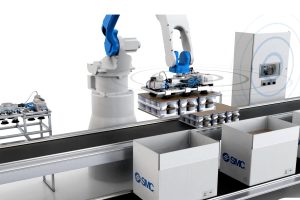Will technology bring a new dawn to the food processing industry?
2023-02-09Society 5.0 is the next stage in Japan’s technological development – the use of self-driving cars and drones to overcome inconveniences arising from social factors and the environment to provide delivery and door-to-door services. Before embracing this new paradigm, the food processing sector must ensure that the benefits of Industry 4.0 and smart technologies are fully realized and absorbed.
Robots, machine vision, sensors, drones and connected devices can all enhance food processing capabilities. In addition to reducing costs and human error, automation can improve efficiency, ensure safety and enhance quality.

Will technology bring a new dawn to the food processing industry?
Every manufacturing facility understands the importance of safety in food processing, and companies rely on their production lines to adhere to the necessary production specifications. Even the most difficult to inspect products must be quality checked with absolute reliability to avoid contamination as well as incorrect sorting and packaging. Recalls resulting from these problems can cost profits and undermine hard-won customer trust.
Vision technology uses cameras and associated software to automatically inspect products on the production line at high speeds, without the need for manual input. These systems can detect every anomaly and inspect products faster than any human can. In addition to operating 24/7, many machine vision systems can upload and store inspection data for manufacturers to access and review.
X-ray inspection systems are also becoming increasingly popular, with manufacturers using this technology to detect contaminants in food products. Incorporating this technology provides an additional layer of quality assurance by detecting metals, glass, sandstone, shale and other materials. More advanced systems can also detect contaminants containing higher-value elements, such as polyvinyl chloride, polytetrafluoroethylene, salt blocks and bone. At the same time, manufacturers can use X-rays to mark defects in other product types, such as missing product in packaging, errant air bubbles or broken product.
The rise of interconnected systems is there for all to see. U.S. management consulting firm McKinsey estimates that the number of IoT-connected devices worldwide will increase to 43 billion by 2023. Smart sensors are a key example, using wireless connections to derive data and support evidence-based decision-making.
Integrated sensors can help manufacturers gain a detailed understanding of their production processes. Once manufacturers know what type of data they need, they can select the right type of sensor to monitor, analyze and process changes in their facilities and production lines.
Sensors can measure and control any data from temperature and pressure, to solids and liquid levels. Temperature sensors are probably the most common sensors used in food processing environments, as they are well suited for appliances such as refrigerators and will alert manufacturers to any anomalies. For example, if the motor overheats and is at risk of shutting down. When choosing a temperature sensor, manufacturers must choose between thermocouples, thermistors, resistance temperature detectors and infrared sensors, depending on the application scenario.
Other sensors are also available. For example, a pressure sensor measures the force applied to each unit of the sensor and is capable of detecting the pressure in a sealed container storing a gas or liquid. This type of sensor can detect any fluctuations or drops in pressure and is often used to maintain water supply and heating systems.
While Society 5.0 may seem almost utopian and futuristic, most food processing facilities are closer to Society 5.0 than companies realize. for food manufacturers that have not fully embraced Industry 4.0, retrofitting legacy equipment can provide a strong return on investment and pave the way for smarter setups.
However, almost every food processing plant has functioning legacy equipment such as sensors, drives and program logic control systems. As retrofit technology evolves, these machines may need to be integrated with new parts that are already equipped with interconnection capabilities. This option can be costly, so at this point in time, there are more cost-effective and simpler solutions that don’t involve completely refurbishing the entire system and starting from scratch.
Instead, manufacturers can retrofit smart technologies, such as smart sensors and X-ray systems, as well as updated human-machine interfaces that will simplify the transition to Social 5.0. For example, smart temperature sensors can be installed on a variety of conventional machines, and their output data will help manufacturers develop predictive maintenance plans. Once a failure is detected, manufacturers can order and replace parts from a reliable parts supplier.